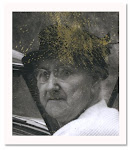I can't even begin to count how many times I drove this road. It's near the summit of Donner Pass in Northern California; the old route 40 of the Sierras. Off in the distance at the far end of Donner Lake is where the Donner Party attempted to survive the winter of 1846-47. There is a state park and campground located where the families lived. And the towns of Gateway and Truckee have tourists far removed from what once happened in the area.
Click on image to see it larger.
Until you've experienced a winter in this area you simply can't imagine what the Donner Party were dealing with. My families cabin was on the western side of the summit. I can remember going in the second floor—which was really the third floor because the "basement" was above ground—more than once. The first floor and basement were completely covered in snow. And it's not a fluffy snow. It's called Sierra Cement for a reason. The summit is where the storms dump their first round of heavy water in storms and the snow depth and weight proves it. I can remember walking along the road and having to duck to get under the power lines; the snow was that deep. The upstairs beam in the cabin was actually two 15-18 inch beams stacked which ran the length of the cabin. Without such beams we would have had the problem so many other cabins had in the heavy snow…complete collapse.
Winter weather at Donner Pass can be brutal. Precipitation averages 51.6 inches (131 cm) per year, much of which falls as snow. At an average of 411.5 inches (10.45 m) per year, Donner Pass is one of the snowiest places in the United States. Four times since 1880 total snowfall at Donner Summit has exceeded 775 inches (19.7 m) and topped 800 inches (20 m) in both 1938 and 1953. To take advantage of the heavy snows, the Boreal Ski Resort was built to the north. Ski resorts in the Lake Tahoe area report an average of 300 to 500 inches (7.6 to 12.7 m) of snowfall per season. Winds in the pass can also become extreme and wind gusts in excess of 100 miles per hour (160 km/h) are common during winter storms. Winter temperatures in the area drop below zero several times each year; the all-time record low for California of −45 °F (−43 °C) was recorded at Boca (east of Truckee) in January 1937.
The winter of 1846-47 was especially severe, and this is generally cited as the single most important factor in the disaster of the Donner Party. In the winter of 2010-11, over 700 inches (1,800 cm) had fallen as of May 23, 2011. Snow depth peaked in early April 2011 with over 250 inches (21 ft) of snow on the ground. (SOURCE: Wikipedia)To say the least, before route 80, the Dwight D. Eisenhower Highway, was built, getting over the summit in the winter was at best a challenge if the road was open at all. It was, and still is, a two lane road. These days it's closed during the winter. But the rest of the year it's a beautiful drive. In fact it's often used in car commercials.
For decades there was a rusty old bus sitting upside down on those rocks a bit east of that tall tree on the right. I never knew the story of that bus, but we all made up some great stories. Eventually sometime in the late '90s, I think, the bus was finally removed.
I miss driving the pass on a warm summer day with the car windows open. It's a wonderful snaky road that's fun to drive. There's a lot to see along this road, so next time you think of staying on interstate 80 get off at Cisco Grove and follow the old 40 through Truckee. I can remember driving it before the freeway was in. In fact, I can remember going over and seeing dynamite blasts where the freeway was being constructed. That really dates me.
_____
Tattered and Lost volumes 1 to 7 available at Amazon.




























